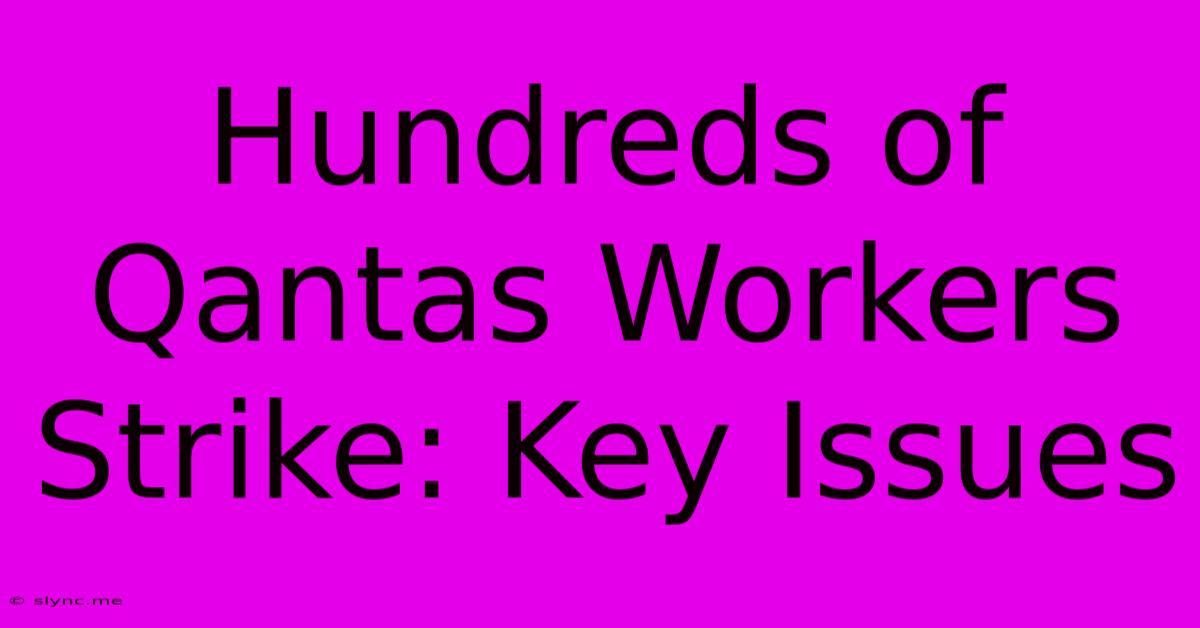Hundreds Of Qantas Workers Strike: Key Issues

Discover more detailed and exciting information on our website. Click the link below to start your adventure: Visit Best Website Mrs.Amykhan. Don't miss out!
Table of Contents
Hundreds of Qantas Workers Strike: Key Issues
Hundreds of Qantas workers, members of the Transport Workers Union (TWU), have recently engaged in strike action, causing significant disruption to flights and impacting thousands of passengers. This industrial action highlights several key issues simmering within the airline industry and specifically at Qantas. Understanding these underlying problems is crucial to grasping the scope and implications of the strike.
Key Issues Fueling the Qantas Worker Strike
The strike isn't about a single grievance; it's a culmination of several long-standing concerns. These include:
1. Wages and Working Conditions: A Core Dispute
A central point of contention is the disparity between Qantas's profitability and the wages and working conditions offered to its employees. The TWU argues that Qantas workers, particularly those in ground handling and maintenance, haven't received fair wage increases reflecting the airline's financial success. They cite concerns about job security, excessive workloads, and a lack of investment in employee well-being as contributing factors. The union contends that Qantas's prioritization of shareholder returns comes at the expense of its workforce.
2. Outsourcing and Job Security: A Threat to Employment
The outsourcing of jobs to third-party contractors is another major issue driving the strike. The TWU argues that this practice undermines job security for Qantas employees and leads to a deterioration in working conditions. Contracted workers often receive lower wages and fewer benefits than directly employed Qantas staff, creating an uneven playing field and eroding morale. The union believes Qantas should prioritize retaining its workforce and investing in its employees.
3. Safety Concerns: A Critical Aspect
Safety concerns regarding maintenance and ground handling operations are also at the heart of the dispute. The TWU alleges that cost-cutting measures have compromised safety standards, leading to increased risks for workers and passengers alike. The union stresses that prioritizing safety should be paramount for an airline and that adequate staffing levels and maintenance resources are essential. This isn't merely about wages; it's a matter of public safety and responsibility.
4. The Impact on Passengers: Collateral Damage
The strike's ripple effect has significantly impacted air travel, leading to widespread flight cancellations and delays. Thousands of passengers have faced inconvenience, frustration, and financial losses. While the workers' grievances are directed at Qantas management, the inconvenience experienced by passengers highlights the broader implications of industrial disputes in the aviation sector.
The Broader Context: Qantas and the Australian Aviation Industry
The Qantas strike reflects broader trends within the Australian aviation industry, including the ongoing debate over the balance between profitability, employee rights, and passenger welfare. The dispute highlights the complexities of industrial relations in a highly regulated and safety-sensitive sector. It underscores the need for constructive dialogue between unions, management, and government to address the underlying issues and find solutions that benefit all stakeholders.
Looking Ahead: Potential Resolutions and Outcomes
The resolution of the Qantas worker strike will likely involve negotiations between the TWU, Qantas management, and potentially government intervention. Achieving a mutually acceptable outcome will require addressing the core issues of wages, working conditions, job security, and safety concerns. The success of these negotiations will be crucial not only for Qantas workers but also for the broader Australian aviation industry and the traveling public. Further strikes remain a possibility if a fair and equitable solution is not reached. The situation warrants ongoing monitoring for developments.

Thank you for visiting our website wich cover about Hundreds Of Qantas Workers Strike: Key Issues. We hope the information provided has been useful to you. Feel free to contact us if you have any questions or need further assistance. See you next time and dont miss to bookmark.
Also read the following articles
| Article Title | Date |
|---|---|
| Times 2016 Person Of The Year Donald J Trump | Dec 13, 2024 |
| Your Team Vs Plzen Match Winner | Dec 13, 2024 |
| Dexter Original Sin A Critical Look At The Series | Dec 13, 2024 |
| Sirena Raketniy Obstril Ukrayini | Dec 13, 2024 |
| Donald Trump Times Poty Twice | Dec 13, 2024 |
